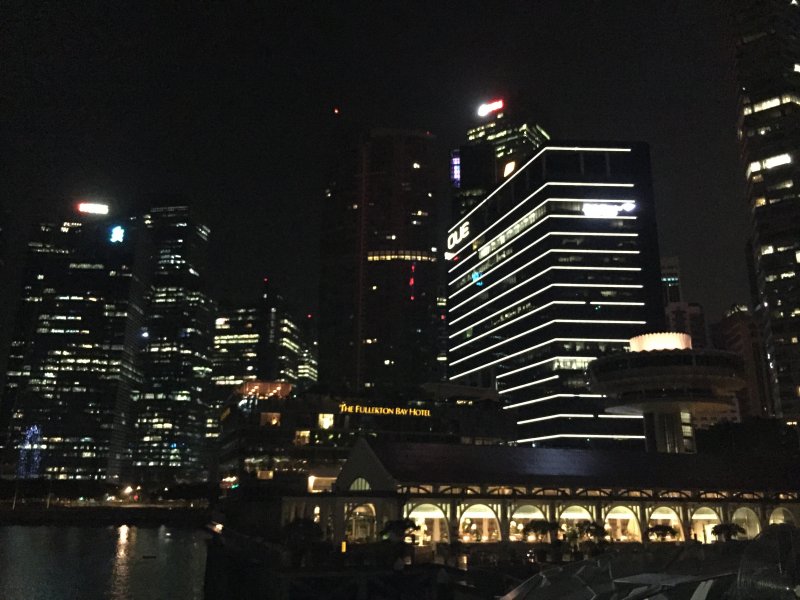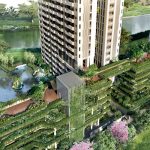Singapore’s Shoebox apartments helps banking sector stability
Table of Contents
Small residential housing size such as shoebox apartments is good for Singapore banks. You may not know it, but having ever smaller housing is almost institutionalised in Singapore’s policies on land, and on the Singapore banking and financial sector.
Ever smaller housing means rising land prices and that means safer asset values for the banks that lend out home loans and hence greater safety for the value of their secured lending for the Singapore’s banking industry.
Image Credits: Singapore Financial District at Night, Paul Ho, iCompareLoan.com
Singapore’s Fiat banking System
Banks create credit by setting aside a reserve known in Singapore as a Minimum Cash balance.
In short, in a fiat currency system, banks can print money (create credit), not exactly print because it has to be repaid. For every dollar that a bank prints, they need to put up a small percentage of the money as a deposit in a MAS account. They have to put the bank’s equity towards this deposit with MAS.
Let’s assume that the Minimum Cash Balance (MCB) is 5% (other countries call it Reserve Ratio), that means that to create $100 to lend to a borrower, they will only need $5 to be set aside. The money to be set aside can be from the bank’s equity.
https://www.icompareloan.com/resources/bank-loans-singapore-mortgage/
How do the Singapore banks lend? what is their profit margins?
It’s not bad right? You create $1,000,000 of loans simply by placing $50,000 deposit in MCB. If banks charge 2% interest on $1,000,000, that means the bank earns (gross): –
- $50,000 deposited into MAS under the MCB funds or otherwise referred to as Invested capital.
- Gross earning $20,000.
- Gross returns = $20,000/$50,000 = 40%.
In short, the bank does not need to have $1,000,000 to lend you $1,000,000. They can just create digital digits and then place them into the deposit account of the borrower. (Of course, what you learn in the text book is, banks take your deposits and lend it out, yes, this too.)
Note: This is a simplified view of a complex banking system.
In reality, bank’s margins are not that high due to regulatory and compliance and other cost of sales incidentals.
Singapore Banks Undertake Risks of Non-Performing Loans (NPL)
While banks can create credit (almost like printing money), banks will also need to underwrite any losses from non performing loans or losses from non repayment, so it is not exactly free money. (Though they do lend out from depositor’s funds too)
But it’s definitely very hard for Singapore banks to lose money from Non-performing loans (NPL) in Singapore from secured lending against residential properties, due to the extremely good residential asset quality supported by Singapore’s land policies of pushing up asset values and making land ever more expensive. Shoebox apartments play a part in this ecology.
Total Debt Servicing Ratio (TDSR), Mortgage Servicing Ratio (MSR) and Low Loan-to-Value Prevents banks from losing money
In Singapore Total Debt Servicing Ratio (TDSR) and Mortgage servicing ratio (MSR) is used to gauge the ability to service the loan and the earning capacity, so that a default situation never really need to happen. Smaller units such as Shoebox apartments are affordable based on price quantum and hence can potentially be good protection for the banks.
Will the banks lose money? Mostly no. This is because MAS restricts the maximum loan-to-value to 75% (previously 80% before 6th July 2018) of the property valuation or transacted price, whichever is lower. What this means is that, if the property prices are firm and appreciating, and even if the prices were to fall a little, the banks will almost always be able to recover their money by selling the property in the open market as mortgagee sale.
Since assets are very safe (such as those shoebox apartments) due to the Singapore government’s relentless push for higher land values, banks can lend safely, hire bankers, pay bankers commission to promote their packages and do customer acquisition.
And in this regard, Mortgage Brokers play a key role in helping banks reach out to more customers in the most cost effective way so that expensive advertising can be minimised and the number of bankers they employ can also be optimised. Mortgage brokers can help you save time to get the best home loans in Singapore and so you also do not waste the bank’s time to do countless frivolous bank loan applications that you may not have the intention of taking up as a mortgage broker helps you to shortlist the key packages.
Singapore Government squeezes people into shoebox apartments for Land Price enhancement
Singapore is fortunate in that the government wants it’s residents to interact closely with each other, and as a result squeezes people into tiny spaces that is built up into shoebox apartments. This is called “land use intensification” where people live in high rise and crowded space. Perhaps in the future, underground too.
Land is released gradually and slowly and deliberately controlled to extract high prices. When demand rises leading to land price rises, only then will the Government consider releasing more land for sale. This makes property developers bid ever higher prices for the land. As affordability has not dramatically increased, the size of residential units are made ever smaller, so as to cover their cost of bidding high. Sometimes, the government releases land so slowly that the land the government releases are getting further and further away, developers take things into their own hands and bid for condominium projects via en bloc sales.
This is also good for the government coffers as the Singapore government made away with lots of money from land sales by timing huge releases of land supply at the peak price.
This leads to a period of indigestion of land supply that takes several years to digest.
High Intensity and crowded living means profitable MRT and Bus services
With higher density living, buses and SMRT lines will become very profitable, never mind the frequent breakdowns. Shopping malls being built or commercial land being zoned into these “hubs” will have a profitable and captive market which in turn makes the shopping malls valuation high and the land it sits on even more valuable.
A captive market of residents forced into tight and crowded living spaces means a high concentration of shoppers and consumers. This leads to more facilities and more connectivity (such as roads and SMRT) which serves to reinforce the property price upward pressure.
It is exactly this perverse nature of managed scarcity that helps support the property prices and asset values.
Squeezing people into tight spaces is good economics.
Crowded Living and Ever Smaller Condominiums are good for Singapore
So Singaporeans and residents are destined to live in ever tinier spaces as it is institutionalised for financial stability to “maintain a stable and sustainable Property market” as land price rises means good collateral value and a safe and good banking system and hence maybe a good economy.
So do not complain that your house is getting smaller, it is good for you.
For advice on a new home loan or Personal Finance advice.
To speak to our Panel of Property agents.
For refinancing advice.







